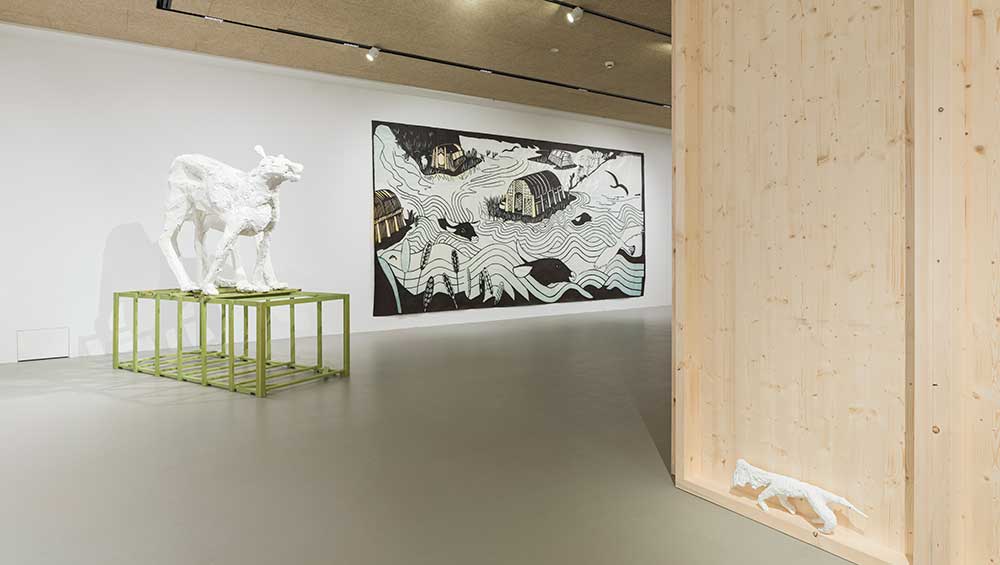
Tribute to Lin May Saeed, Works 2006 – 2023. Sculptures, reliefs, cut-paper silhouette. Realised by GAMeC, Bergamo in Collaboration with Biennale Gherdëina 9. Courtesy of The Estate of Lin May Saeed and Jacky Strenz, Frankfurt/Main. Photo: Tiberio Sorvillo.
Val Gardena, Dolomites, Italy
31 May – 1 September 2024
by BETH WILLIAMSON
Val Gardena in the Dolomites in the north-east of Italy is a valley in the mountains. Unesco terms the Dolomites as being of outstanding universal value and its 18 peaks present a geomorphology that is breathtaking. The experience of being in that landscape is perhaps akin to what it might feel like to step into one of the infinite landscapes painted by the German artist Caspar David Friedrich in the early 19th century. The sublime.
This year’s Biennale Gherdëina, the ninth in its life and curated by Lorenzo Giusti and Marta Papini, brings contemporary art and artists into dialogue with nature under a generously interpreted curatorial theme – The Parliament of Marmots. In this part of Italy, three languages are routinely spoken – Italian, German and Ladin. It was the ancient Ladin myths of the Fanes, the area’s legendary population, that gave Giusti his overarching idea for this biennale and it is a serious proposition despite his, at times, playful interpretation. The area’s long history of woodcarving going back to the 17th century, and often in the form of religious icons, continues to inform local and international artists in this year’s biennale. While ecocritical discourses in contemporary art flourish, Giusti’s vision is not conceptual. Instead, it is emotional and existential, it is taking the wild, however that is understood, as a creative direction and the mountains become the hunting ground for the artists involved. In a trajectory of becoming, artists explore ideas of multi-speciesism, of reconstruction and transformation in a manner that shows real respect for human and non-human animals alike, as well as for nature where wildness and wilderness become players in a fight for survival.
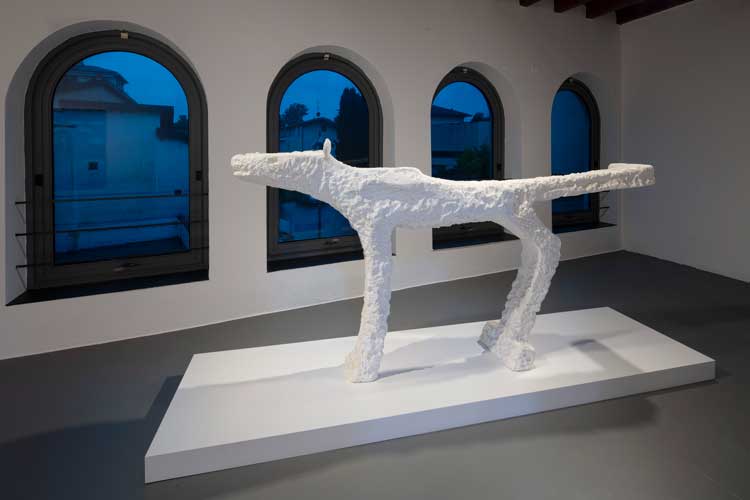
Lin May Saeed. Installation view, GAMeC, Bergamo, 2024. Photo: Antonio Maniscalco. Courtesy GAMeC - Galleria d'Arte Moderna e Contemporanea di Bergamo.
Biennale Gherdëina 9 is dedicated to the artist Lin May Saeed (1973-2023) who died just weeks after conversations with Giusti began. Originally, he had planned to invite Saeed to be one of the biennale’s commissioned artists and recreate her iconic polystyrene animal sculptures using local wood. As she was already too ill to participate, plans changed and instead the biennale shows a small exhibition of her sculpture in the town of Ortisei and a larger companion exhibition at GAMeC in Bergamo as part of a related two-year project, Thinking Like a Mountain. The 19 commissioned artists in this year’s Biennale Gherdëina include Ingela Ihrman, Femmy Otten and Diana Policarpo, with more than a dozen other artists contributing to the diffuse display of painting, sculpture, installation, performance, film and photography in venues throughout Ortisei and surrounding areas. Everyone involved is clear that it should be a meaningful experience for the local communities with lasting impact.
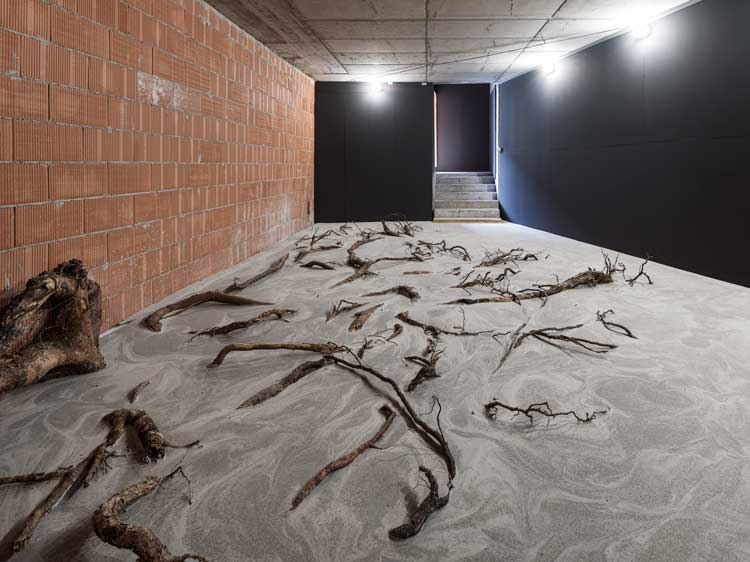
Nadia Kaabi-Linke. Mushroom, 2024. Installation, dimensions variable. Commissioned by Biennale Gherdëina 9. Supported by IFA - Institut für Auslandsbeziehungen. Photo: Tiberio Sorvillo.
Nadia Kaabi-Linke’s installation Mushroom (2024) in a disused underground space follows from an earlier work where she filled a room with tree branches and leaves. Here, she scatters the roots of trees that fell in summer storms, protruding from a concrete floor in a way that animated the friction between sculpture and nature within the building.
In another disused space, this time an old theatre hall, Ruth Beraha’s poweful sound installation Il Cielo è Dei Violenti (2024) begins like a meditation and ends in frenzy. She spoke to a Ladin ornithologist to understand the area as a location for migrating birds, then used the birdsong to create a soundscape within the architecture.
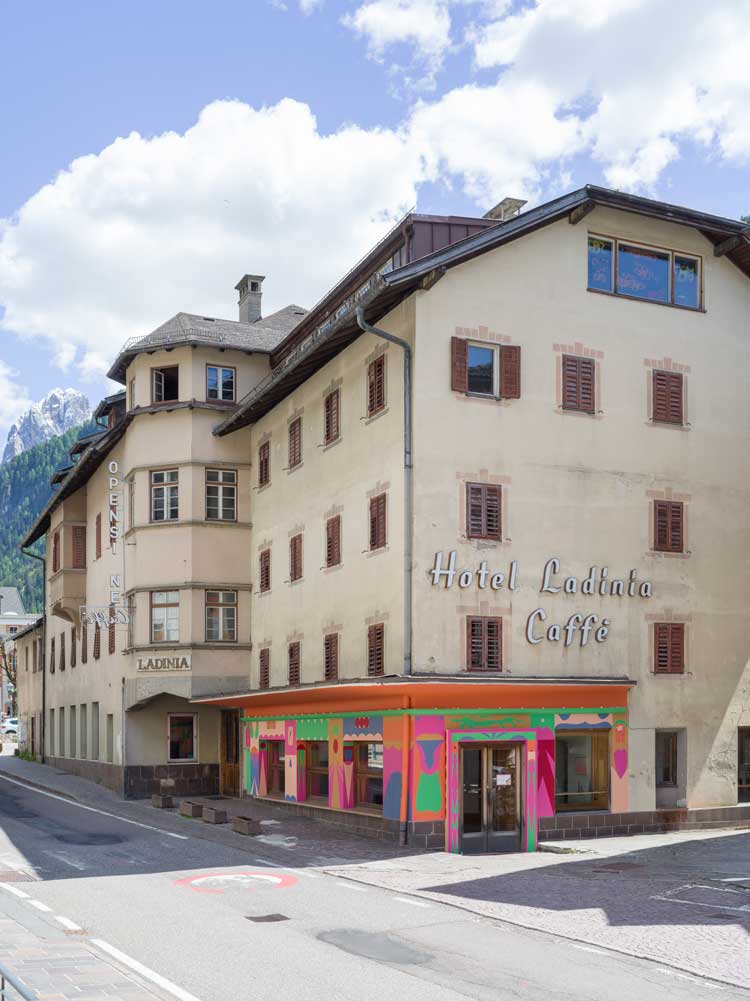
Nassim Azarzar. The Edge of the Forest, 2024. Wallpainting, dimensions variable. Commissioned by Biennale Gherdëina 9. Photo: Tiberio Sorvillo.
The empty building of the Hotel Ladinia houses work by six artists, including Beraha again alongside Nassim Azarzar, Chiara Bersani, Michael Höpfner, Alessandro Biggio and Daniele Genadry. Azarzar’s eye-catching wallpainting The Edge of the Forest (2024) adorns the facade of the historic building, marking it as a cultural site and breathing new life into its stripped-down and tired interiors. Azarzar’s abstract patterns act as a skin that envelopes the building and codify the relationship between nature, humankind and the universe.
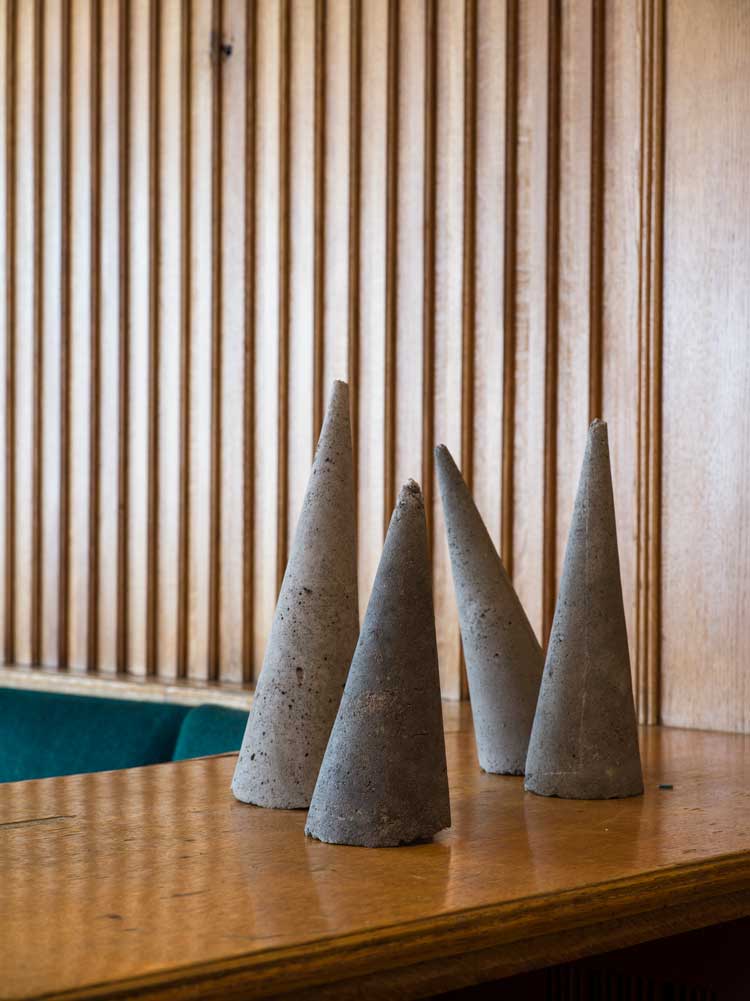
Alessandro Biggio. Ash Cones, 2010-ongoing. Ash, variable dimensions. Photo: Tiberio Sorvillo.
Inside, Biggio’s slender and elegant Ash Cones (2008-ongoing) sit grouped, variously, on countertops and window ledges, playing with ideas of multiplicity and singularity. These small conical sculptures have the appearance of being moulded in robust concrete, but are instead fragile and constructed from the titular ash. Conveying at once a sense of the elemental (material) and solids in space (form), Biggio’s work here asks viewers to reflect on their own existence, what is presented and what is represented. It is modest and subtle, and deeply powerful. Genadry, a Lebanese American artist, usually works on a large scale, but for this commission has worked with much smaller, and more potent, images. In her series of 20 paintings, Apparitional Mountains (pink) I-XX (2023-24), Genadry melds and mixes landscapes of the Lebanon and the Dolomites.
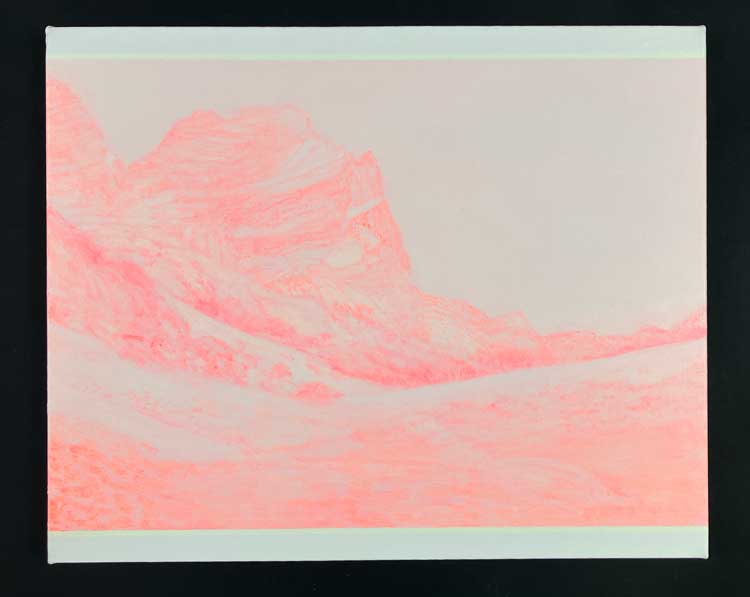
Daniele Genadry. Apparitional Mountains (pink) X, 2023-24. © the artist.
These small paintings (just 35 x 50cm at their largest) hang in odd locations around the walls of the Hotel Ladinia, often on the edge of perception, catching the corner of the eye with an intensity that draws the viewer in. These landscapes instil a hyperawareness in looking that is all the more present because of the knowledge that they won’t be there for ever on a geological time scale.
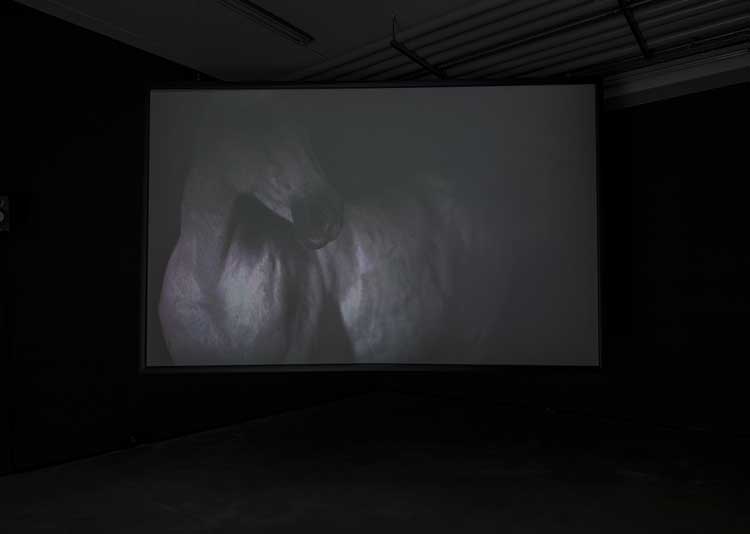
Valentina Furian. Centauro, 2023. HD video, colour, stereo sound. Courtesy the Artist and Fundación PROA. Photo: Tiberio Sorvillo.
On the outskirts of Ortisei, in the less beautiful spaces of industrialisation and human intervention, the biennale continues its trail. Valentina Furian’s film installation Centauro (2023) takes a sculptural approach to space. The screen is suspended in the centre of the room, inviting viewers to walk around and experience sound and image from different perspectives. The film asks what a centaur might look like today. The artist focuses in closely on the nervous, glistening body of an animal restrained so that muscles, nerves and joints move like a rolling landscape and press against the limits of the screen without ever coming to rest.
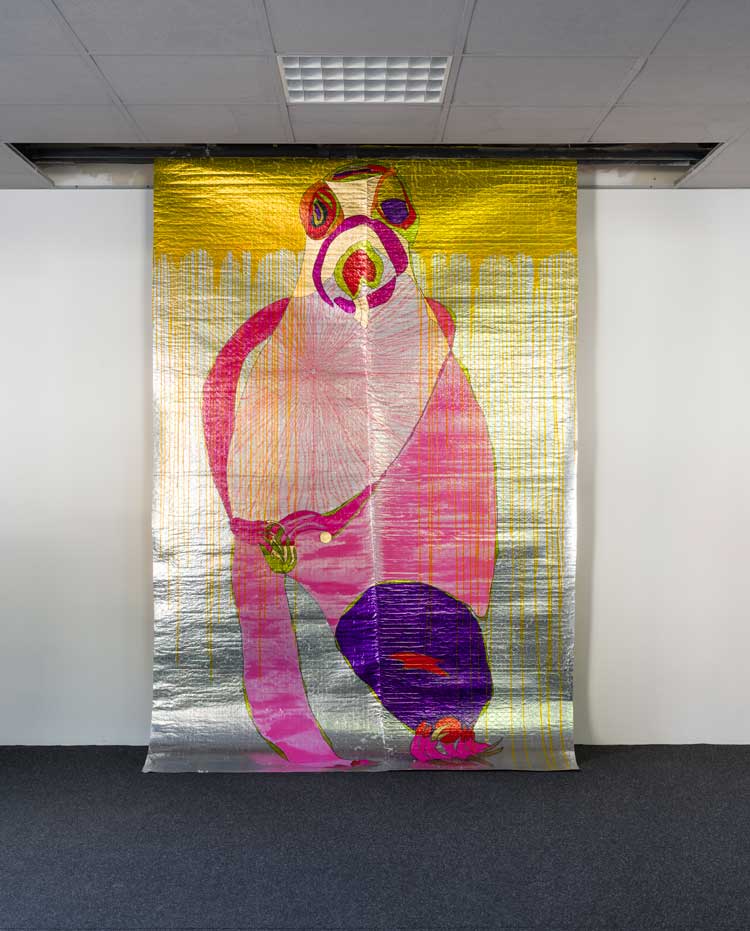
Atelier dell’Errore. Marmottoloide, 2024. Mixed media and gold leaf on polyester and carbon fibre, dimensions variable. Commissioned by Biennale Gherdëina 9. Photo: Tiberio Sorvillo.
Upstairs, the commissioned work of Atelier dell’Errore, a collective of 11 neurodivergent artists, takes the form of Marmottoloide (2024), a brightly coloured image of a marmot-type animal that resides on the wall. Outside, Vela Alpina (2024) is a six-metre-high sail hoisted on a lamppost, and referencing the sea that shaped the Dolomites 250,000 years ago. The work is constructed from an experimental material that transforms the thermal blankets used to shelter migrants on the Mediterranean shores into a sail, from a material of rescue to a material of hope as the biennale’s pocket-size guidebook explains it.
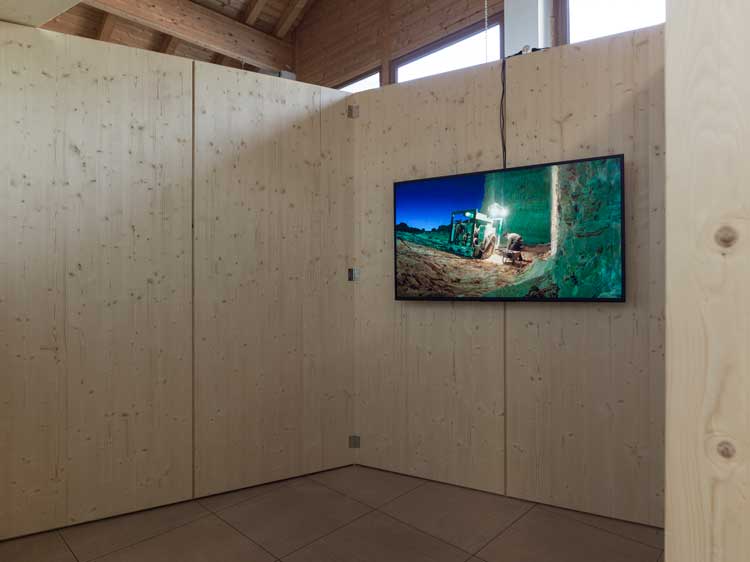
Shuruq Harb. In the Presence of Absence, 2024. Video, 14 min. Courtesy of the Artist. Commissioned by AM Qattan Foundation. Photo: Tiberio Sorvillo.
Another space hosts about 10 films. Some of the most striking are Shuruq Harb’s In the Presence of Absence (2024), referencing and reflecting on Palestinian poet and author Mahmoud Darwish’s series of long lyrical meditations, and Janis Rafa’s Landscape Depressions (2023) sees humans in long deep sleep while animals take over the spaces and the landscape.
It is in the landscape of the Dolomites itself that Biennale Gherdëina 9 really comes into its own. Going to visit these works in the landscape is a pilgrimage of sorts. For her performance, a wild version of her work L’Animale, Chiara Bersani inhabits the top of a large boulder in Vallunga. In an engagement with the classical dance piece The Dying Swan as interpreted by Anna Pavlova, Bersani brings an audience into direct confrontation with the artist’s disabled body while performing a song to passersby, almost as if she has emerged from the forests.
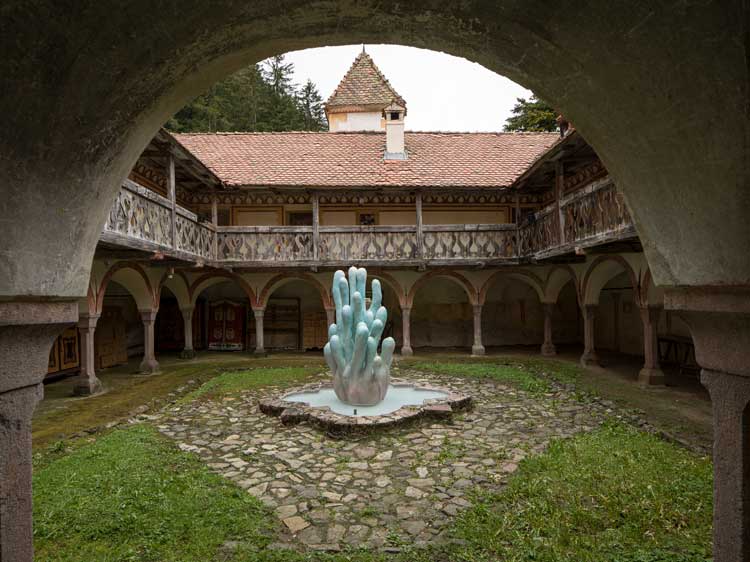
Diana Policarpo. Anguane’s Fountain, 2024. Mixed media sculpture, 280 x 120 x 120 cm. Anguane’s Fountain, Stream (COBRACORAL), 2024. Six multi-channel audio installation. Commissioned by Biennale Gherdëina 9. Photo: Tiberio Sorvillo.
Elsewhere, Diana Policarpo’s Anguane’s Fountain (2024) sits within the courtyard of Castel Gardena. Its form was developed from the shape of a carnivorous sponge from the ocean depths – Chondrocladia lampadiglobus – and was conceived by the artist as a tribute to the anguanes, female figures in Ladin mythology associated with water and understood as guardians of the mountains, forests and waters. An ethereal sound composition brings together verbal and nonverbal, human and nonhuman sounds from the animals and the landscape. Altogether it is an evocative installation.
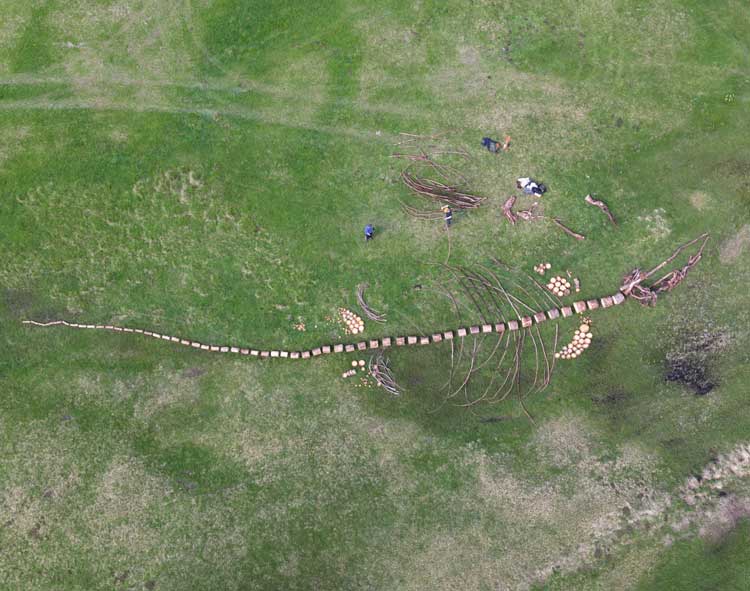
Ingela Ihrman. First Came the Ocean, 2024. Environmental installation, 25 x 5 m. Courtesy the Artist and Ögonblicksteatern i Umeå, Sweden. Photo: Tiberio Sorvillo.
Perhaps the work that embodies the spirit of this year’s Biennale Gherdëina best of all is Ingela Ihrman’s commission First Came the Ocean (2024). Inspired by a large marine skeleton displayed in Ortisei’s local history museum, Ihrman created a similar structure made from wood and on a much larger scale. The materials came from local fallen trees, weakened by the bark beetle epidemic, cut and positioned to resemble the ancient marine fossil. At about 25 metres long, the huge structure is sited on a hilly plateau near Juac where it will slowly return to the ground. You have to make an effort to walk up the hill and encounter it as you reach the plateau. This might be viewed as symbolic of the legacy of Biennale Gherdëina 9, enriching the soil, bringing new ideas into view, revivifying the dialogue between nature and culture and amplifying communication between human and non-human animals. It’s an ongoing conversation.
• Lin May Saeed is shown as part of Thinking Like a Mountain at GAMeC, Bergamo, Italy, until 22 September 2024.